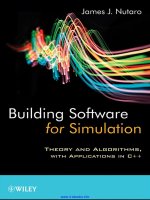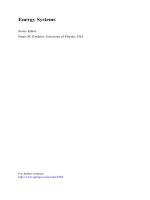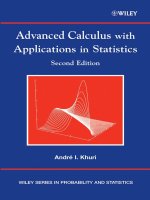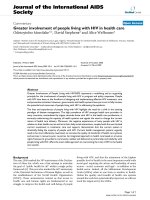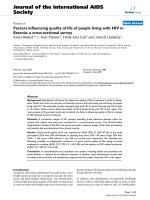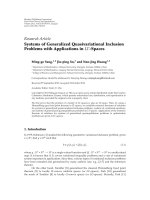Theory of neutron fluctuations with applications in nuclear safeguards and noise diagnostics in research and power reactors
Bạn đang xem bản rút gọn của tài liệu. Xem và tải ngay bản đầy đủ của tài liệu tại đây (398.32 KB, 6 trang )
THEORY OF NEUTRON FLUCTUATIONS WITH APPLICATIONS IN
NUCLEAR SAFEGUARDS AND NOISE DIAGNOSTICS IN RESEARCH
AND POWER REACTORS
IMRE PÁZSIT
Division of Subatomic and Plasma Physics, Nuclear Engineering Group
Chalmers University of Technology SE-412 96 Göteborg, Sweden
E-mail:
Abstract: Neutron fluctuations in both low power systems (“zero power reactor noise”) [1],
[2] and power reactors (“power reactor noise”) [2], [3] carry important information about the
system. The origin of the fluctuations is different in these two regimes, and consequently,
they are described by different mathematical methods, as well as that they have different
characteristics and application areas. At low power (critical assemblies and research reactors)
the fluctuations are due to the branching process (multiple generation of several neutrons in
fission); in power reactors it is the technological processes of random character, such as
boiling of the coolant, vibration of mechanical structures etc., which induce the neutron
noise. Common to them is that neutron fluctuations can be used to diagnose the state of the
system, either by determining some of its parameters (reactivity coefficients, void content
etc.), or by detecting beginning anomalies (excessive vibrations, flow anomalies etc.).
In this report the principles and selected applications of both zero power noise and the power
reactor noise will be given. The current significance of research in power reactors is also
indicated by some on-going collaborations, such as the large EU-supported co-ordinated
research project, CORTEX, whose goal is the development and verification of core
diagnostic methods [4], and the planned noise diagnostic option of the US DoE supported
Versatile Test Reactor (VTR) Project [5]. A particular aspect of these projects is that the
development and verification of calculational and experimental methods for power reactors
is supported by dedicated experiments and measurements in zero-power and research
reactors. In these latter, the perturbations need to be generated artificially; on the other hand,
unlike in power reactors, determination of the parameters of the noise source as well as
measurements of the induced neutron noise can be performed simultaneously under
controlled circumstances.
Keywords: neutron noise, reactor diagnostics, safeguards, research reactors, power reactors.
1. INTRODUCTION
The theory and application of neutron noise diagnostics has a long and successful history
[1] – [3]. The theory of zero power reactor noise, i.e. neutron fluctuations in low power systems
or in samples of fissile material, is used to determine the subcritical reactivity of a reactor during
start-up, or during the operation of an accelerator driven subcritical system (ADS). Another
application is nuclear safeguards, i.e. detection, identification and quantification of fissile nuclear
material, either for detecting illicit trafficking, or to verify the integrity and fissile content of
spent nuclear fuel, before depositing it in the final repository.
The methods of power reactor noise diagnostics are used for a continuous, non-intrusive
surveillance of power reactors. Both operational parameters in the stationary state, such as the
moderator temperature coefficient in PWRs or the void content in BWRs, can be continuously
determined and possible changesbeing detected, or the occurrence of abnormal processes, such
as fuel and control rod vibrations, boiling in PWRs, flow anomalies in both PWRs and BWRs, or
instability in BWRs can be detected in an early stage. This way they can be identified and
1
quantified at an early stage, such that preventive actions can be taken. In the forthcoming
illustrations of these applications will be given.
2. ZERO POWER REACTOR NOISE
2. 1. Methodology
The methodology is based on probability balance equations, also called Kolmogorov or
Chapman-Kolmogorov equations, or just master equations. Usually an energy-independent
(“one-group”) description is used, with an infinite homogeneous medium, in order to arrive
analytically tractable equations. The traditional theory deals with the temporal evolution of the
probability distributions of discrete quantities, such as the probability P(N ,C ,Z ,t ) of having N
neutrons and C precursors in the system, and having Z detector counts between time 0 to t.
Usually, only the few lowest order moments, such as the variance (second moment) or skweness
(the third moment) of the quantities are sought.
One traditional application is to determine the subcritical reactivity of a system, driven by
a stationary source, from the relative variance σZ2 (t) / Z(t) of the detector counts Z(t ) measured
during a time period t (the variance to mean or Feynman-alpha method). Accounting for only
one (average) group of delayed neutrons, it is given as
2
−α t
⎛
⎡ ⎛ 1 − e −αt ⎞
⎞⎤
σZ (t)
⎟⎟ + A ⎜⎜1 − 1 − e ⎟⎟⎥
(1)
= 1 +Y (t) = 1 + ε ⎢A1 ⎜⎜1 −
⎟⎟⎥
⎟
2⎜
⎢ ⎜⎝
⎟⎠
⎜
Z(t)
αt
α
t
⎝
⎠
d
⎣
⎦
where ε is the detector efficiency, A1 and A2 constants, containing the first two moments of the
number distribution of fission neutrons, and the delayed neutron fraction and decay constant.
Y (t) is the so-called Feynman Y -function, whose time dependence is determined by the
d
parameters α and αd , i.e. the prompt and delayed neutron time constants, where
β −ρ
(2)
Λ
with ρ being the reactivity and Λ the prompt neutron generation time. From a measurement of
the function Y (t) , the reactivity can be extracted from the prompt neutron decay constant, which
is determined by a curve fitting of (1) to the measured data. An illustration of the Feynman Y function for different values of the reactivity ρ is shown in Fig. 1.
α=
Fig. 1 Feynman-Y values as functions of time, for various values of subcritical
reactivity in units of 10-4
2
Another application is the field of nuclear safeguards. i.e. detection, identification and
quantification of hidden or non-classified nuclear material. This is based on deriving theoretical
formulae for the three lowest order moments of the number of detected neutrons, emitted from
the item through spontaneous fission and subsequent internal multiplication, and measuring the
detection rates of single, double and triple coincidences. This process makes it possible to
determine a few unknowns of the sample, including sample mass. This is called “multiplicity
counting”.
To give a flavor of the methodology, we show the backward master equation for the
number of neutrons leaving the sample, due to one initiating neutron. The source neutron may
undergo some fission reactions with probability p before escaping from the sample, hence the
multiplicity (number distribution) of the neutrons per source event will differ from that of the
spontaneous fission, and will be dependent on the sample mass. A backward type master
equation for this probability reads as
k
p(n) = (1− p)δ n,1 + p∑ k=1 p f (k) ∏ p(ni )
∞
(3)
i=1
{n1 +n2 +...+nk =n}
and the corresponding equation for the generating funcion reads as
h(z) = (1 − p) z + p q f ⎡⎢h(z)⎤⎥
⎣
⎦
(4)
From this generating function the factorial moments can be derived by derivation w.r.t. z.
Whereas this formalism and the applications have been known and used for quite some
time, significant new developments were made presently in the methodology, which will be
described below.
2. 2. New developments and results
The above methods, using discrete pulse counting, suffer from the dead time effect, and the
shortage of one of the most commonly used detector materials (He-3). Hence, we have recently
initiated research to see whether the same statistical information (variance of the number of
counts in a reactor for reactivity measurement, or the factorial moments of neutrons detected
from an unknown sample, for multiplicity measurements in nuclear safeguards) can be extracted
from the statistical moments of the continuous currents of fission chambers.
This required to set up master equations for the continuous stochastic processes,
represented by the detector signals, as functions of the underlying discrete detection process.
Elaboration of such a methodology was successful, and we found that the same information can
be obtained from the detector currents both for multiplicity counting [6], [7] and for reactivity
measurements [8]. Experimental verification of the methodology is underway in measurements
at the educational reactor of the Budapest University of Technology and Economics [9].
3. POWER REACTOR NOISE
3.1. Methodology
In power reactors several technological processes (boiling of the coolant/moderator in a
BWR, vibrations of mechanical constructions in a PWR etc., commonly called “noise sources”),
cause the medium in which the neutron transport and multiplication takes place to fluctuate in
time and space. These fluctuations of the reactor material, expressed in terms of cross section
fluctuations, will cause fluctuations of the neutron flux around its mean valueThe measured
neutron noise can be used either to detect, identify and quantify the noise sources, if the dynamic
transfer function of the unperturbed core is completely known, or to monitor changes in the state
3
of the unperturbed core, such as reactivity coefficients, stability properties, if the properties of
the noise source can be assumed to be known.
The methodology used to describe these stochastic processes is based on the linearised
form of the Langevin technique. Starting with the space-time dependent diffusion equations in
the form
1 ∂φ(r,t)
= D∇2φ(r,t)+[νΣf (r,t)(1− β)−Σa (r,t)]φ(r,t)+ λC(r,t)
v ∂t
(5)
∂C(r,t)
= βνΣf (r,t)φ(r,t)−λC(r,t),
∂t
(6)
and
splitting up the neutron flux and the cross sections into mean values and fluctuations, neglecting
second order terms, subtracting the static equations and eliminating the delayed neutron
precursors with a temporal Fourier transform, one arrives finally at the following generic
equation for the neutron noise:
! (r, ω ) δφ (r, ω ) = S (r, ω ).
L
(7)
Here the noise source S (r, ω ) is given, in terms of the fluctuations of the absorption cross
! (r, ω ) corresponds to the unperturbed
sections, as S(r, ω) = φ0(r)δΣa (r, ω) , and the operator L
state of the system. With the Greens’ function of equation (7), the neutron noise can be
expressed as
δφ(r, ω) = ∫ G(r,r ', ω)S(r ', ω)dr ' .
(8)
The purpose of power reactor noise studies is that, by measuring the neutron noise, to
identify either the noise source by knowing the the transfer function from calculations, and hence
identify anomalies in the core, by inverting (8), or to determine some parameters of the transfer
function, not affected by the noise source, for known forms of the noise source (such as a white
noise background noise).
Examples of the first type (identifying anomalies/disturbances) include [2]
•
•
•
•
•
•
determining the location (radial position) of vibrating control rods in PWRs
detecting and quantifying core barrel vibration properties in PWRs
measuring velocity of coolant flow in PWRs
determining the position of a local thermal hydraulic instability in the core of a BWR
detecting and classifying detector tube vibrations and impacting in BWRs
determining two phase flow parameters in BWRs.
Examples of determining system parameters (properties of the transfer function) include
•
•
determining of the moderator temperature coeffient (MTC) of PWRs;
determining the margins of instability of a BWR.
One case of power reactor noise diagnostics will be mentioned here for illustration (several
examples are given in [2]). Fig. 4 shows the location of a thermal hydraulic instability together
with the detector positions used in the noise analysis-based localization of the instability (being
due to an improperly seated fuel assembly), together with the position pointed out by the noise
analysis based localization technique.
3.2 New developments
The current line of research is focused partly on the development of efficient
computational methods for the fast and accurate calculcation of the transfer runction G(r,r ', ω)
4
Fig. 2. Result of the localisation algorithm in the Forsmark-1 case (local instability event).
The unseated fuel element is marked with a square, and the noise source identified by the
localisation algorithm with a circle.
of real inhomogeneos cores, such as the dynamic core simulator CORE SIM [10], and inversion
methods for unfolding the perturbation from the measured neutron noisem by inverting Eq. (8)
by machine learning methods. Another line of developments is the design of zero power reactor
experiments, in support of the new models and diagnostic algorithms for power reactors. These
lines are all pursued in the EU-supported project CORTEX [4]. Another current method under
development is a methodology to determine the axial dependence of the void content along the
whole height of a BWR from the measured neutron noise from the fix in-core detector signals. A
neutron noise based method was currently suggested to solve this problem, and was tested in
simulations [11]. Dedicated measurements are being set up in a special channel for inducing twophase flow in the reflector of the zero power reactor CROCUS of EPFL with air injection (Fig.
3), to test the methodology and its performance, for a proof of principle. The experimental
channel, and the two fission chambers next to it for cross-correlation measurements, are seen
right to the core on the vertical cross section of the core (left hand side figure). This latter project
is pursued in the project VOID of EPFL and PSI, funded by swissnuclear [12], [13].
Fig. 3. A schematic view of the core od CROCUS and the experimental channel for air
injection, with two fission chambers nearby for the measurement of the neutron noise.
5
4. CONCLUSION
The use of neutron fluctuations and neutron noise diagnostics is an active and intensively
developing area of nucler engineering and nuclear safeguards. In parallel with theory and method
development, dedicated experiments and measurements performed in research reactors are a very
effective tool to support research and development in both nuclear safeguards and power reactor
diagnostics.
5. REFERENCES
1. I. Pázsit and L. Pál, Neutron Fluctuations - a Treatise on the Physics of Branching
Processes. Elsevier Ltd., London, New York, Tokyo (2008)
2. I. Pázsit and C. Demazière, Noise Techniques in Nuclear Systems. In: Handbook of
Nuclear Engineering, Ed. Dan G. Cacuci, Vol. 3, pp 1629 – 1737, Springer (2010)
(book chapter)
3. M.M.R. Williams. Random Processes in Nuclear Reactors. Pergamon Press, Oxford
(1974)
4. CORTEX project, EU-Horizon 2020
/>5. K. Pasamehmetoglu, Versatile Test Reactor Overview. Advanced Reactors Summit VI.
San Diego, California, January 29-31, 2019.
/>6. I. Pázsit, L. Pál and L. Nagy, Multiplicity counting from fission chamber signals in the
current mode. Nucl. Instr. Meth. A 839, 92 - 101 (2016)
7. L. Nagy , I. Pázsit and L. Pál, Two- and three-point (in time) statistics of fission
chamber signals for multiplicity counting with thermal neutrons. Nucl. Instr. Meth. A
929, 148 - 155 (2019)
8. Y. Kitamura, I. Pázsit and T. Misawa, Determination of neutron decay constant by timedomain fluctuation analyses of neutron detector current signals. Ann. nucl. Energy 120,
691 - 706 (2018)
9. L. Nagy et al., Two- and three-point statistics of fission chambersignals for multiplicity
counting with thermal neutrons. M&C 2019, International Conference on Mathematics
and Computational Methods Applied to Nuclear Science and Engineering. August 2529, 2019, Portland, Oregon, USA
10. C. Demazière, CORE SIM: A multi-purpose neutronic tool for research and education.
Annals of Nuclear Energy 38, 2698-2718 (2011).
11. V. Dykin, I. Pázsit, Simulation of in-core neutron noise measurements for axial void
profile reconstruction in Boiling Water Reactors. Nucl Technol. 183, 354-366 (2013)
12. V. Lamirand, M. Hursin, G. Perret G, P. Frajtag, O. Pakari, A. Pautz. Future
experimental programmes in the CROCUS reactor. In: Proc International Group On
Research Reactor 2016. Berlin: European Nuclear Society, Brussels, Belgium; 2016.
p. 284–92.
13. M. Hursin et al., “Measurement of the gas velocity in a water-air mixture in CROCUS
by neutron noise technique,” in M&C 2019 International Conference on Mathematics
& Computational Methods Applied to Nuclear Science & Engineering, 2019
6


